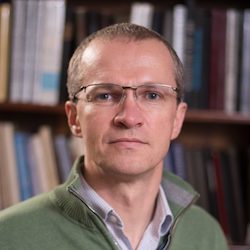Graduate Student Seminar
October 25, 2024
12:45 p.m. ET
Wean Hall 7500
October 25, 2024
12:45 p.m. ET
Wean Hall 7500
Large-scale deployment of first-principles electronic structure calculations in combination with the ever-increasing power and availability of massively parallel supercomputers have launched in past couple of decades an entirely new paradigm in modern materials science. Intuition and serendipity that were the hallmarks of materials discovery are now complemented by theory-guided searches, which have resulted in a number of important findings. However, using theory and computations to propose, with a high degree of confidence, novel and useful metastable materials still represents a significant challenge. In this talk I will present our recent attempts to solving some of the problems hindering theory-guided discovery and design of metastable phases with the particular focus on covalent and partially ionic solids. More specifically, I will discuss experimental realizability (synthesizability) of metastable crystalline phases (or polymorphs) in connection to the specific features of the potential energy surface leading to an effective computational methodology to search for, and rank potentially metastable states according to their realizability. Next, I will talk about our efforts in developing computational methods to enable large-scale assessment of the polymorph lifetimes. These are predicated on the novel solution to the problem of finding an optimal atom-to-atom mapping between infinitely periodic systems. Lastly, an emerging description of disordered and glassy systems as statistical ensembles of small-cell, periodic local minima on the potential energy surface will be discussed. This approach enables predictive modeling of atomic disorder and glasses without the need for experimental inputs. In all of these areas our recent developments offer predictions of relevant properties, which, in turn, allow for more rational and reliable searches for useful metastable materials.
 Vladan Stevanović, Colorado School of Mines & National Renewable Energy Laboratory
Vladan Stevanović, Colorado School of Mines & National Renewable Energy LaboratoryStevanović is a theoretical physicist working in computational materials science. Currently he is an Associate Professor in the Department of Metallurgy and Materials Engineering at Colorado School of Mines, with joint appointment at the National Renewable Energy Laboratory (NREL). Vladan’s research stands at the intersection between applied solid-state physics, material science, large-scale computations and big data. Motivated by renewable energy applications (photovoltaic, thermoelectric, power electronics and other), his work combines development and use of computational methods to predictively model relevant properties of solids with the goal to facilitate discovery and design of novel functional materials. Before joining Colorado School of Mines, he spent two years as a postdoctoral researcher at NREL and obtained his degrees from École Polytechnique Fédérale de Lausanne (EPFL), Switzerland, and Faculty of Physics, University of Belgrade, Serbia.
July 22 2025
10:00 AM ET
Materials Science and Engineering
"Artificial Intelligence Enabled Quantification of Defects in Stainless Steel 316 L parts printed via Binder Jetting," presented by Pooja Maurya
6142 Scott Hall
July 25 2025
3:00 PM ET
Materials Science and Engineering
"Enabling High-Voltage Cathode in All-Solid-State Batteries," presented by Young-Geun Lee
2327 Wean Hall
July 29 2025
11:00 AM ET
Materials Science and Engineering
Graduate Programs Information Session
Learn more about the master's and doctoral programs in materials science and engineering at CMU.
July 30 2025
10:00 AM ET
Materials Science and Engineering
"The Data Driven Discovery of Singlet Fission Materials," presented by Siyu Gao
2327 Wean Hall
August 13-15 2025
Materials Science and Engineering
Workshop on Methods for Three-Dimensional Microstructure Studies
The workshop is intended for researchers at all levels and will combine presentations on 3D microstructure science as well as practical presentations on the tools and methods for reconstructing, analyzing and synthesizing.
Scott Hall 5201 (Bosch Sparks Conference Room)